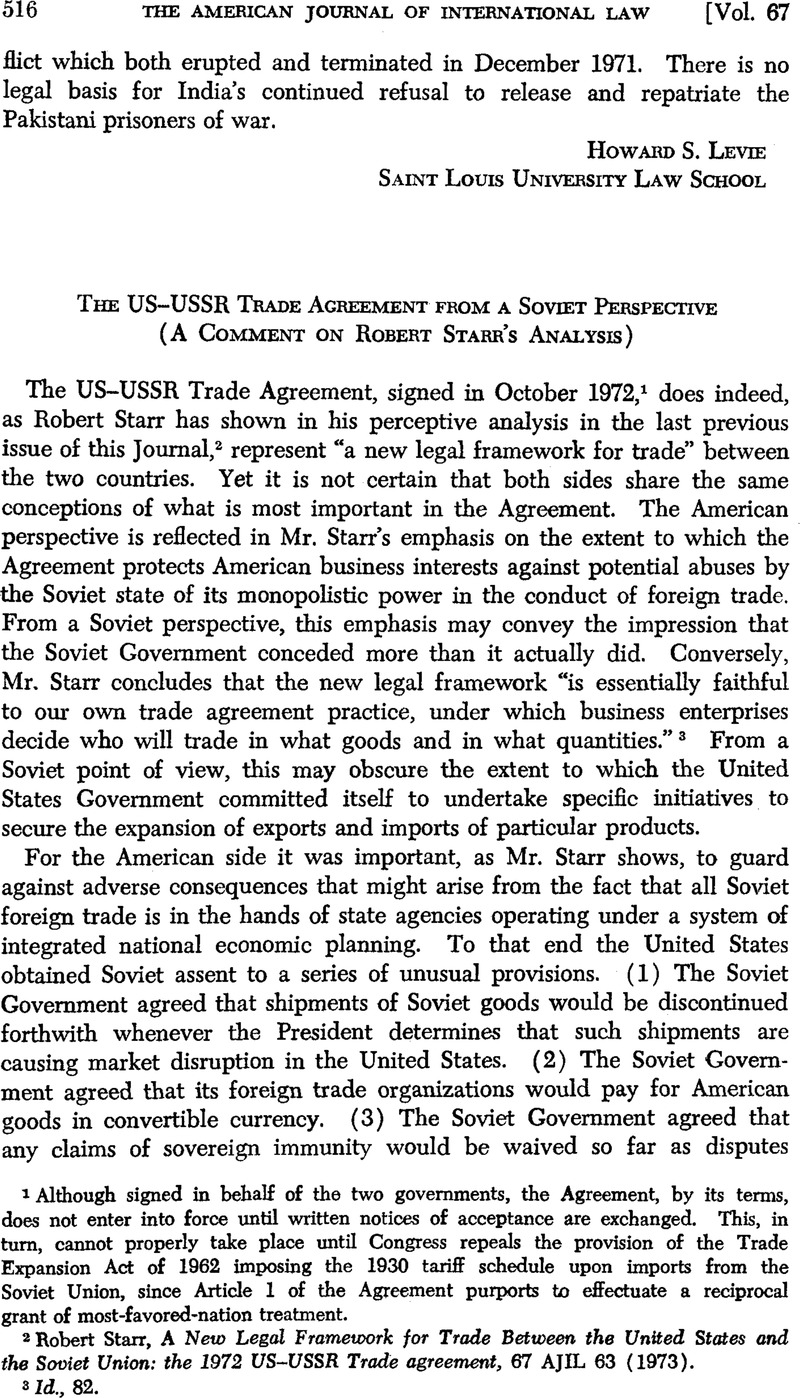No CrossRef data available.
Published online by Cambridge University Press: 28 March 2017

1 Although signed in behalf of the two governments, the Agreement, by its terms, does not enter into force until written notices of acceptance are exchanged. This, in turn, cannot properly take place until Congress repeals the provision of the Trade Expansion Act of 1962 imposing the 1930 tariff schedule upon imports from the Soviet Union, since Article 1 of the Agreement purports to effectuate a reciprocal grant of most-favored-nation treatment.
2 Starr, Robert, A New Legal Framework for Trade Between the United States and the Soviet Union: the 1972 US-USSR Trade agreement, 67 AJIL 63 (1973)Google Scholar.
3 Id., 82.
4 Id., 72.
5 See supra note 1 and infra p. 520.
6 Starr, supra note 2, at 69.
7 Id., 70.
8 See Berman, , The Legal Framework of Trade Between Planned and Market Economies: The Soviet-American Example, 24 Law & Contemp. Prob. 482, 525–28 (1959)Google Scholar.
9 Cf. Starr, supra note 2, at 65.
10 Id., 66, n. 9.
11 Id., 70, n. 18.
12 Mr. Starr takes the traditional American view that “[t]he large bulk of [Soviet] exports will no doubt continue to consist of raw materials and semi-manufactured products, to which tariffs are not a significant obstacle.” Id., 69. This overlooks the fact that discriminatory tariffs are in fact a significant obstacle to imports of such semi-manufactured products. More important, it does not take account of the potential American market for Soviet manufactured products. In the past, such products have encountered serious obstacles not only in the form of discriminatory tariffs but also in the form of a general unfamiliarity with, and hostility to, imports from Communist countries. In fact, many types of sophisticated Soviet manufactured goods are highly competitive in world markets. Familiar examples are Soviet surgical equipment, oil drilling equipment, machine-tool microscopes, educational testing equipment, cameras, watches, and others. The Soviet Union exported about four billion dollars’ worth of goods to Western Europe and Japan in 1972, of which a substantial proportion fell outside the categories of products to which our tariffs are not a significant obstacle.
13 The classic statement of this view is found in Domke, and Hazard, , State Trading and the Most-Favored-Nation Clause, 52 AJIL 55 (1958)Google Scholar. Cf. Hoya, , The Legal Framework of Soviet Foreign Trade, 56 Minn. L. Rev. 1 at 23–28 (1971)Google Scholar. A contrary position is taken in Berman, op. cit. supra note 8, at 525, n. 133.
14 Starr, supra note 2, at 68.
15 In the Exchange of Letters attached to the Agreement, it is provided that “United States companies will receive treatment no less favorable than that accorded to business entities of any third country in all matters relating to accreditation and business facilitation. Applications for accreditation by United States firms will be handled expeditiously.” Letter of N. Patolichev to Peter G. Peterson, Oct. 18, 1972. 67 Dept. State Bull. 600 (1972); also in US Dept. of Commerce, V.S.-Soviet Commercial Agreements 1972, Texts, Summaries, and Supporting Papers, Jan. 1973, at 96.
16 Starr, supra note 2, at 82.